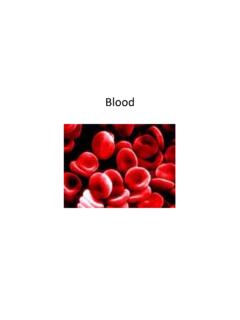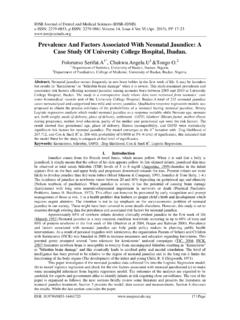Transcription of fluid management in neonates and infants
1 fluid management IN. neonates AND infants . CONTENTS. INTODUCTION. A WORD ABOUT NEONATAL PHYSIOLOGY. FASTING GUIDELINES. INTRAOPERTIVE fluid management . POSTOPERATIVE fluid management . ELECTOLYTE IMBALANCE. COMPOSITION OF IV FLUIDS. INTRODUCTION. WHY IS fluid management IMPORTANT IN. neonates -- - Physiology different from adults. - All don't need the same IV fluids (either in quantity or composition). - If wrong fluids are given, neonatal physiology is not well equipped to handle them. - Serious morbidity can result from fluid and electrolyte imbalance. NEONATAL PHYSIOLOGY. HOW IT IS DIFFERENT??? All babies are born with an excess of TBW, mainly ECF- - Adults have 60% water (20% ECF, 40% ICF). - Term neonates have 75% water (40% ECF, 35% ICF).
2 - Preterm neonates have more water (23 wks: 90% : 60% ECF, 30% ICF). DISTRIBUTION OF BODY WATER. NEONATAL PHYSIOLOGY. High water content provides a large volume of distribution for water- soluble medications. Low fat and muscle content provides a small reservoir for drugs that depend on redistribution into these tissues for termination of drug effect. ANAESTHETIC IMPLICATIONS . - Water soluble drugs have larger volume of distribution, require larger initial dose eg., antibiotics, muscle relaxants - Drugs depending on redistribution into fat have longer clinical effect eg., thiopental - Drugs redistributing into muscle have longer clinical effect eg., fentanyl NEONATAL PHYSIOLOGY. After birth, there is efflux of fluid from (ICF) to (ECF).
3 This floods the neonatal kidneys eventually resulting in a salt and water diuresis by 48-72 hours. This loss results in physiological weight loss in the first week of life. ECW compartment is larger in preterm neonates - the weight loss is greater. Term infants are loose up to 10% of their birth weight as compared to 15% weight loss in premature neonates . Failure to loose this ECF may be associated with morbidities like - Patent ductus arteriosus (PDA). - Necrotizing enterocolitis (NEC). - Chronic lung disease (CLD). NEONATAL PHYSIOLOGY. RENAL FUNCTION. - At birth : Functionality is only 25 %. - Complete maturation of renal function - by 2 yrs of age - t1/2 of drugs excreted by glomerular filtration is prolonged - The physiological range for urine osmolality in neonates 50mmol/L to 600 mmol/L in preterms and 800 mmol/L in term infants .
4 NEONATAL PHYSIOLOGY. Cardiovascular physiology - infants more sensitive to hypovolemia due to- relatively low contractile mass/gram of cardiac tissue limited ability to myocardial contractility in ventricular compliance extremely limited ability to stroke volume need to HR to cardiac output( Treppe effect). NEONATAL PHYSIOLOGY. fluid losses- - Apart from sensible water loss, neonates have additional water losses due to evaporation from the skin and respiratory tract - insensible water loss (IWL). - Insensible water losses -higher in preterm infants - Evaporation through the skin -70% of IWL. - From the respiratory tract- 30% of IWL. NEONATAL PHYSIOLOGY. - Increased insensible water loss (IWL). Increased respiratory rate Surgical malformations (gastroschisis, omphalocele, neural tube defects).
5 Increased body temperature: 30% increase in IWL per C rise in temperature High ambient temperature: 30% increase in IWL per C rise in temperature Use of radiant warmer and phototherapy: 50% increase in IWL. Decreased ambient humidity. Increased motor activity, crying: 50-70% increase in IWL. - Decreased insensible water loss (IWL). Use of incubators Humidification of inspired gases in head box and ventilators Use of plexiglas heat shields Increased ambient humidity Thin transparent plastic barriers reduce upto 30% IWL. Anaesthetic concerns - Covering the neonate during transportation and during surgery - Maintenance of OT temperature FASTING GUIDELINES. EARLIER GUIDELINES . Fasting Time (hr). Age Milk & Solids Clear Liquids <6 months 4 2.
6 6-36 months 6 3. >36 months 8 3. NEW FASTING GUIDELINES. EUROPEAN SOCIETY OF ANAESTHESIA ( 2011 ). FASTING GUIDELINES . - 2 hours for clear liquids - 4 hours for breast milk - 6 hours for non human milk, Infant formula - 8 hours for solid food ADVANTAGES OF THESE LIBERAL GUIDELINES- - Prevent dehydration and hypoglycemia - Reduce the risk of aspiration INTRAOPERATIVE fluid . THERAPY. DEFICIT THERAPY- TO COMPENSATE FOR. DEHYDRATION OR FASTING. MAINTAINENCE THERAPY TO COMPENSATE FOR. LOSS DUE IWL AND URINE. REPLACEMENT THERAPY- FOR BLOOD LOSS AND. THIRD SPACE LOSSES. ASSESSMENT OF fluid AND. ELECTROLYTE STATUS. History: Physical Examination: - Weight: Most important criteria - Skin/Mucosa: Altered skin turgor, sunken AF, dry mucosa, edema etc Cardiovascular: Tachycardia can result from too much (ECF excess in CHF).
7 Or too little ECF (hypovolemia). Delayed capillary refill can result from low cardiac output Hepatomegaly can occur with ECF excess Blood pressure changes very late Lab evaluation: - Serum electrolytes and plasma osmolarity - Urine output - Urine electrolytes, specific gravity - Blood urea, serum creatinine - ABG. management . Goal: Allow initial loss of ECF over first week (as reflected by wt loss), while maintaining normal intravascular volume and tonicity (as reflected by HR, U O, lytes, pH). Subsequently, maintain water and electrolyte balance, including requirements for body growth. Individualize approach according to response of the child and age. DEFICIT DUE TO FASTING. HOURLY REQUIREMENT BASED ON HOLLIDAY AND.
8 SEGAR 100ml water for 100 calories expended 4 2 1 rule based on b. wt. CHILDS RESPONSE. TO FLUIDTHERAPY. SHOULD ALWAYS. BE MONITORED. Millers anaesthesia 7th edition fluid deficit due to fasting management - - Hourly maintenance requirements x hours of fluid restriction - 50% 1st hour - 25% each in next 2 hours MAINTAINENCE fluid IN. neonates . MEETS THE LOSSES DUE TO IWL AND URINE. * fluid and Electrolyte management in Term and Preterm neonates , Indian journal of pediatrics, volume 75 - march 2008. MAINTAINENCE fluid . CHOICE OF fluid ????? - Term Babies and Babies With Birth Weight > 1500 Grams DAY 1 - 10% Dextrose to maintain a glucose infusion of 4-6mg/kg/min DAY 2 TO 7 - 10% Dextrose and sodium and potassium to be added after 48.
9 Hours - Preterm Baby With Birth Weight 1000-1500 Grams DAY 1 - 10% Dextrose DAY 2 TO 7 - 10% Dextrose and sodium and potassium to be added after 48 hours AFTER DAY 7 - Fluids should be given at 150-160 ml/kg/day and sodium supplementation at 3-5 mEq/kg should continue till 32-34 weeks corrected gestational age. MAINTAINENCE fluid DURING. SURGERY. - The maintenance fluid used during surgery should be isotonic such as sodium chloride or Ringer lactate /Hartmann's solution in infants . - neonates in the first 48 hours of life should be given dextrose during surgery. - Maintenance fluid to be calculated by Holliday and segar for patients more than 4 wks of age. Guide for Maintenance fluid Therapy Newborn Term Day 1 50-60 ml/kg/day D10 W.
10 Day 2 80 ml/kg/day D10 W. >Day 7 100-150 ml/kg/day D5-D10 1/4 NS. Older Child 4-2-1 rule (Holliday & Segar method). ROLE OF GLUCOSE IN. PERIOPERATIVE PERIOD. Lack glycogen stores Hyperglycemia is more commonly encountered Response to anaesthesia and surgery Anxiety Pain Hypoglycaemia brain damage Hyperglycemia Osmotic diuresis dehydration and electrolyte imbalance The present recommendations is that the replacement fluid used should either be free of dextrose or should not have more than 1% dextrose.*. *Perioperative fluid therapy in pediatrics, Pediatric Anesthesia 2008 18: 363 370. EXCEPTIONS TO THIS ???? neonates in the first 48 hours of life Preterm and term infants already receiving dextrose containing solutions Children on parenteral nutrition preoperatively Children of low body weight (less than 3rd %tile) or having prolonged surgery.










